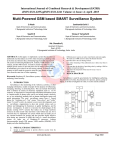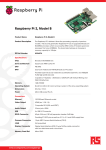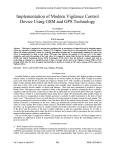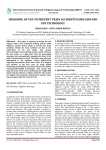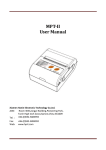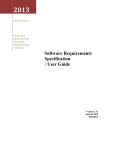Download Secure Provenance Transmission for Streaming Media
Transcript
ISSN No: 2348-4845 International Journal & Magazine of Engineering, Technology, Management and Research A Peer Reviewed Open Access International Journal Secure Provenance Transmission for Streaming Media Server in Video Monitoring V. Madhuri M.Tech, Embedded Systems, Sindhura College of Engineering and Technology. ABSTRACT: In recent years an obvious need emerged to improve the way the video content is delivered over the Internet. As multimedia consumption became significant part of the overall traffic usage, coupled with the emergence of mobile browsing content, providers needed a reliable and robust way to deliver content to end users. In order to simplify the process of content management and delivery and overcome limitations of streaming video through firewalls, leading companies adopted streaming over HTTP as predominant way of video streaming. Since video service providers have no control over bandwidth availability over the Internet, adaptive streaming is employed to provide uninterrupted video delivery even as the available bandwidth varies. These solutions have been around for a couple of years with most popular implementations being Smooth Streaming , HTTP Dynamic Streaming, and HTTP Live Streaming - HLS. All solutions have the same underlying architecture - server side contains segmented video sequences and manifest file that describes content properties and lists segment URLs. Segments are offered at different bit rate levels which allow switching between bitrates when needed. Client side decides what bit rate segment to download based on the current bandwidth conditions and other factors, such as CPU and memory usage. Index-Terms: Raspberry Pi processor, USB camera, Display unit, Ethernet. I. INTRODUCTION: The proliferation of the Internet, embedded systems, and sensor networks has greatly contributed to the wide development of streaming applications. Volume No: 2 (2015), Issue No: 8 (August) www.ijmetmr.com M.Shirisha Assistant Professor, Sindhura College of Engineering and Technology. Examples include real-time financial analysis, locationbased services, control of automated systems. This diversity of data sources accelerates the importance of data provenance to ensure secure and predictable operation of the streaming applications. Data provenance is considered as an effective tool for evaluating data trustworthiness, since it summarizes the history of the ownership and the actions performed on this data. As an example considered a battlefield surveillance systems gathers enemy locations from various sensor deployed in vehicles, air-crafts, satellites, etc.., and manages queries over these data. Now a day’s research people’s are mostly preferred data mining applications used so many areas such as web service, communication and security in surveillance systems. The biometric applications are very popular in security all areas in that one of the best one is face recognition, here in captured image human faces are detected by using LBP algorithm for further verification and security purposes. In this paper one of the challenging task is human face is tracking and recognition is one the main role in this designed system. This automatic face recognition conditions by using CCTV ongoing research to overcome so many problems before it can be require the strength of human perception systems. Here the image quality is very important for both recognition and tracking human faces. For this face detection mainly three approaches are generally used for face detection: feature based, template matching, Eigen values based. In this paper we used LBP technique for face detection on captured images effectively then compared to existing methods. In this paper , we use high performance Raspberry Pi processor. Video data is captured from a USB camera, the captured images sent to Raspberry Pi and transferred over Internet through Ethernet under the control of the ARM11 chip, and then the monitor client will receive the compressed data frame to restructure, and recompose video images by using HTTP protocol. August 2015 Page 35 ISSN No: 2348-4845 International Journal & Magazine of Engineering, Technology, Management and Research A Peer Reviewed Open Access International Journal II. RELATED WORK: 2.1 BLOCK DIAGRAM: Figure-1: block diagram of project 2.2. EXISTING METHOD: In the existing method if we want to monitor the video on internet first of all record the video by using camera. Store the video into CD or DVD or pen drive or any other device. Then the stored video can be uploaded on internet. But the main drawback present in existing system is it is not uploaded live video on internet. Therefore the users can’t get live information by using this method. 2.3. PROPOSED METHOD: The proposed method is used to overcome the drawback present in existing method. The design for the video encoding system involves various aspects such as the selection of the hardware platform and the embedded operating system. The development board with ARM architecture is selected as the hardware platform. Start-up codes, OS kernel and user’s application programs are together stored in a NAND FLASH. Application programs run in 64MB SDRAM, which can also be used as the room of various data and the stack. A CMOS camera capturing videos is connected to a USB interface in the board. This system is used to design a capturing continuous streaming of videos like live cricket matches etc. capturing these live data and videos are stored inside internet by using HTTP protocol. Volume No: 2 (2015), Issue No: 8 (August) www.ijmetmr.com Figure-2: Raspberry Pi processor Your Raspberry Pi board is a miniature marvel, packing considerable computing power into a footprint no larger than accredit card. It’s capable of some amazing things, but there are a few things you’re going to need to know before you plunge head-first into the bramble patch. The processor at the heart of the Raspberry Pi system is a Broadcom BCM2836 system-on-chip (SoC) multimedia processor. This means that the vast majority of the system’s components, including its central and graphics processing units along with the audio and communications hardware, are built onto that single component hidden beneath the 256 MB memory chip at the centre of the board. It’s not just this SoC design that makes the BCM2836 different to the processor found in your desktop or laptop, however. It also uses a different instruction set architecture (ISA), known as ARM. A better-quality picture can be obtained using the HDMI (High Definition Multimedia Interface) connector, the only port found on the bottom of the Pi. Unlike the analogue composite connection, the HDMI port provides a high-speed digital connection for pixel-perfect pictures on both computer monitors and high-definition TV sets. Using the HDMI port, a Pi can display images at the Full HD 1920x1080 resolution of most modern HDTV sets. 3.2 USB CAMERA: A webcam or USB camera is a video camera that feeds its image in real time to a computer or computer network. Unlike an IP camera which uses a direct communication using Ethernet or Wi-Fi, a USB camera is generally connected by USB cable, FireWire cable, or similar cable. The common uses as a video camera for the World Wide Web gave the webcam its name. Other popular uses include security surveillance, computer vision, video broadcasting and recording social videos. Webcams are known for their low manufacturing cost and flexibility, making them lowest cost form of video telephony. They have also become a source of security and privacy issues, as some built in webcams can be activated via spyware. August 2015 Page 36 ISSN No: 2348-4845 International Journal & Magazine of Engineering, Technology, Management and Research A Peer Reviewed Open Access International Journal 3.3 HTTP PROTOCOL: Internet (or The Web) is a massive distributed client/ server information system as depicted in the following diagram. Many applications are running concurrently over the Web, such as web browsing/surfing, e-mail, file transfer, audio & video streaming, and so on. In order for proper communication to take place between the client and the server, these applications must agree on a specific application-level protocol such as HTTP, FTP, SMTP, POP, and etc. •Quoting from the RFC2616: “The Hypertext Transfer Protocol (HTTP) is an application-level protocol for distributed, collaborative, hypermedia information systems. It is a generic, stateless, protocol which can be used for many tasks beyond its use for hypertext, such as name servers and distributed object management systems, through extension of its request methods, error codes and headers.” IV. EXPERIMENTAL RESULTS: Figure-3: TCP/IP network 3.4 HYPER TEXT TRANSFER PROTOCOL (HTTP): Figure-5: Hardware interfacing HTTP (Hypertext Transfer Protocol) is perhaps the most popular application protocol used in the Internet (or The WEB). •HTTP is an asymmetric request-response client-server protocol as illustrated. An HTTP client sends a request message to an HTTP server. The server, in turn, returns a response message. In other words, HTTP is a pull protocol; the client pulls information from the server (instead of server pushes information down to the client). Figure-4: HTTP protocol system •HTTP is a stateless protocol. In other words, the current request does not know what has been done in the previous requests. •HTTP permits negotiating of data type and representation, so as to allow systems to be built independently of the data being transferred. Volume No: 2 (2015), Issue No: 8 (August) www.ijmetmr.com Figure-6: Output of Project (1) Figure-7: Output of Project (2) V. CONCLUSION: In this paper, secure provenance transmission for streaming media server in video monitoring. It will succeed in network video monitoring system. This system has lowcost good openness and portability and is easy to maintain and upgrade. It has advantage at low power consumption. In the future, this can be extended in 4 ways as mentioned below: August 2015 Page 37 ISSN No: 2348-4845 International Journal & Magazine of Engineering, Technology, Management and Research A Peer Reviewed Open Access International Journal 1.Maintain a separate database system for network remote video so that we can monitor the video at any instant of time. 2Maintain an alarm system so that the security can be increased. 3.Extracting key frames from the captured raw video which are stored and streamed into the server. 4. We can upgrade the system by incorporating multiple cameras to cover large number of places. VI. REFERENCES: 1. Chen Rongfang, Wang Haibin, Hu Zhenhua, Zheng Pin. Remote Monitor System of Power Network Based on Embedded Internet Technology. Microcomputer Information. vol. 24, no. 7-2, pp. 78-80, 2008 S3C6410 Microcontroller User’sManualRevision1,http://www.samsungsemi.com/ 3. Zhang YuJie, Huai Weihua, Tian Ze. Design of Industrial Temperature Monitoring Equipment Based on Embedded Linux Operating System. Computer Engineering and Design, vol. 30, no. 17, pp. 3940-3942, 2009. 4. Video4Linux User’s Manual, http://www.v4l.com.cn. [5] Craig Zacker. “TCP/ IP Administration”.China Water Power Press. Beijing ,vol 8 ,pp:12- 18.1998. 5. HUFFMAN, D. A. (1951). A method for the construction of minimum redundancy codes. In the Proceedings of the Institute of Radio Engineers 40, pp. 1098-1101. 6. CAPON, J. (1959). A probabilistie model for run-length coding of pictures. IRE Trans. On Information Theory, IT-5, (4), pp. 157-163. 7. Yoshiro Imai, Yukio Hori : A Mobile Phone-Enhanced Remote Surveillance System with Electric Power Appliance Control and Network Camera Homing, IEEE Computer(Third International Conference on Autonomic and Autonomous Systems ICAS 2007). 2. Siyi.Zou, “Design and Application of Embedded Linux”. Beijing: Tsinghua University Press, pp:90-93,2002. Volume No: 2 (2015), Issue No: 8 (August) www.ijmetmr.com August 2015 Page 38





